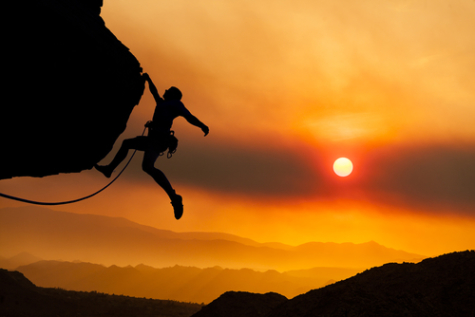Debunking Hollywood is LWON’s very occasional series that takes a hard science look at common TV and movie tropes. 
Our hero is in dire trouble yet again. He stands on the rooftop, a villain in front of him, his feet inches from a seven-story fall. Sweat glistens on his brow as he fearlessly throws a punch but the villain is too quick. In a swift movement, the evil man kicks our hero in the stomach and he plummets toward the pavement below, the villain cackling with glee and twisting his mustache.
Ah! But just as his fate looks sealed, 20 feet down he catches the bottom of the fire escape and hangs precariously by one arm. Whew!
This kind of last-ditch-grab-for-safety is standard fare in almost any action movie. (The scene you’ve just read was an excerpt from my as-yet-unpublished trashy detective novel, Blades of Courage, part of the Slade McGee series. No, no, make that Icy Hot, part of the Chet Heartstrong series. I’m still ironing out the details.)
But how possible is it in reality? As a former rock climbing instructor, I’ve taken my share of falls – always with a rope firmly attached to me. Every time it happens, I’m shocked by just how fast a person can fall. Most times I don’t even know what’s happening until the rope catches me five or ten feet down.
It’s hard to explain so allow me to demonstrate the difference between a Hollywood fall and a real life fall. First, a Hollywood fall:
(skip to 0:37)
(and 7:40)
And now a real fall (warning, climbers are prone to obscenities while falling):
(skip to 0:55 and 5:00)
(skip to 3:00)
I’ve heard that in moments of crisis people say time stands still. But in my experience, it doesn’t happen when you fall – if anything, time speeds up. Still, what if a climber (or secret agent) had the presence of mind and opportunity to grab something on the way down? Is it even possible? To find out, I called Kirk Bjorling, who tests climbing equipment for the Oregon-based outdoor company Metolius.
“Things speed up really fast when they are falling through the air. It doesn’t take but a couple meters to exponentially increase the impact force,” Bjorling says.
Bjorling spends much of his time chucking bags off of rocks and snapping climbing equipment in hydraulic presses to see how much force it all can take. He says “impact force” is a term that encorporates weight and speed into a single number (often given in units called “newtons”). To illustrate this, stand on a scale and jump up and down a few times. Notice that your weight bounces with you. That’s impact force.
Now take that first James Bond clip. Pierce Brosnan was 164 pounds at the time (the lightest Bond ever, I’m told) and fell a dozen feet or so. Bjorling pulls out his calculator and says that the amount of force delivered to Bond’s hands when he grabs that bar is about 29 kilonewtons.
Doesn’t sound so bad, right? Wrong. That’s the equivelent of holding about 6,500 pounds for the split second it takes him to stop his body.
“[It’s like] I’m walking down the street and my friend wants to throw a baseball to me but instead he throws a Ford F650,” Bjorling says. “You’re going to break every bone in your body at 15 kilonewtons.”
No human could hang on to a bar with three tons hanging from them, even for a milisecond. But, Bjorling says, there is a catch. If the human body can stretch, even a tiny bit, that number goes way down. If you can stretch, say, four inches, that number is more than cut in half (still 2,500 pounds). At eight inches, it’s down to a paltry 1,200 pounds.
This, he says, it the key to making safe climbing equipment. It’s often not about the strongest rope but rather the strongest, stretchiest rope that delivers the lowest impact force to the person tied to the end of it. So how much does the human body stretch? For that I called Joy Reidenberg, an amazing researcher and anatomy teacher at Mt Sinai in New York.
“Oh, I’m afraid to venture a guess on that,” she writes in an email. “However, I know the spine can accommodate quite a bit of stretch in the hydration of the intervertebral discs. We grow about an inch overnight when we sleep, due to water replenishing what we lose during the day when we are compressing the discs with our weight.”
It’s probably fair to say that the human body has a few inches of give but nowhere near eight. Of course, it’s possible for Bond to absorb a little more impact force by flexing his muscles when he grabs the bar and releasing them like a reverse pull-up. But even the best climbers I spoke to said that this would be impossible after just a couple feet.
So there you have it. If you find yourself dangling from a building with an evil villain twirling his mustache above you and you spot a flagpole just ten feet down … it’s a good time to consider negotiating with the villain.
Photo Credit: Shutterstock and The United Artists Media Group
Special thanks to Metolius


It’s gravity’s fault. Everything is. Here’s what happens when you catch yourself in a fall: https://www.lastwordonnothing.com/2012/11/15/falling/. And thank you, Erik, it’s a hair-raising post.
Man. Watching those real-life falls gives me the willies.
Does it make any difference if the ‘stretch’ is in the flagpole bending, instead of the person?
I’ll jump in here: I think the answer is no, no difference. The trick is to increase the amount of time before the crash. But maybe I’m not understanding the bending flagpole correctly.
Ooo, good point. We discussed this on the James Bond clip – whether the tiny movements in the ladder would absorb force. I think we felt that the movements were too small. But a really bouncy flagpole? Hmm. My sense is that they are usually pretty stiff but we’re only talking about a few inches needed to slow the fall.